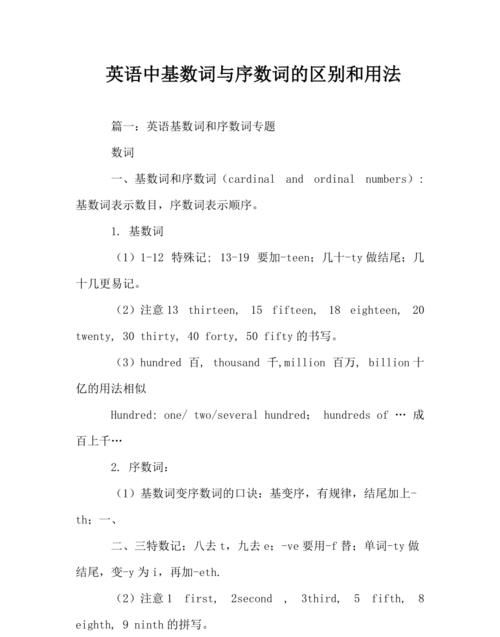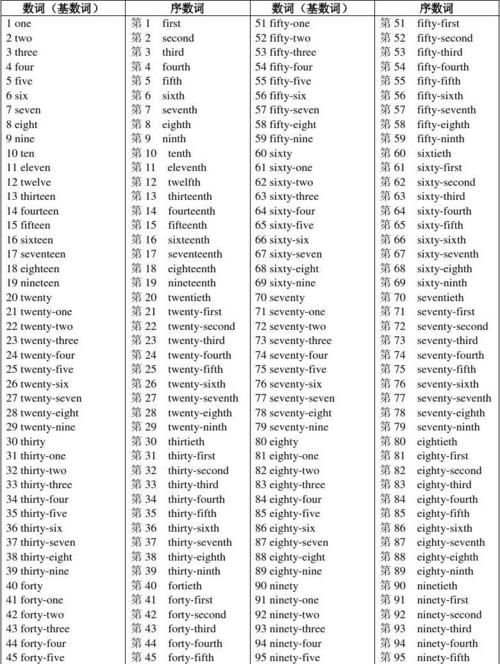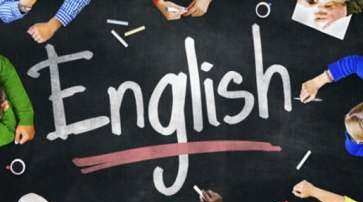本文目录
中考英语数词知识点总结
漫长的学习生涯中,大家都背过各种知识点吧?知识点是知识中的最小单位,最具体的内容,有时候也叫“考点”。想要一份整理好的知识点吗?以下是我为大家整理的数词的英语知识点总结,仅供参考,大家一起来看看吧。
数词的英语知识点总结 1
(一)基数词在英语中表示数目的词称为基数词。
1.基数词的构成
(1)1-20
one,two,three,four,five,six,seven,eight,nine,ten,eleven,twelve,thirteen,fourteen,fifteen,
sixteen,seventeen,eighteen,nineteen,twenty
(2)21-99 先说“几十”,再说“几”,中间加连字符。
23→twenty-three,34→thirty-four,
(3)101—999先说“几百”,再加and,再加末两位数或末位数;
586→five hundred and eighty-six,803→eight hundred and three
(4)l,000以上,先从右往左数,每三位数加一个“,”,第一个“,”前为thousand.第二个“,”前为million,第三个“,”前为billion,然后一节一节地表示。
9,785→nine thousand, seven hundred and eighty-five
6,260,309→six million two hundred and sixty thousand three hundred and nine
750,000,000,000→seven hundred and fifty, billion
2.基数词的用法
(1)表示数量
Eg. 一 How many books would you like?
一I would like two.
(2)表示号码
eg.My phone number is 6887789.
(3)表示时间
eg.I watch CCTV News at seven o’clock every evening.
(4)表示“…十”的数词的复数可以表示人的岁数或年代。
eg. He is in his early thirties.他有三十来岁(31—34岁):
This took place in the 1930s.这事发生在二十世纪三十年代;
(5)表具体数字时,hundred,thousand,million用单数。
eg. There are six hundred students in our grade.
(6)表不确定的数字时,数词用复数。若带名词,再加of ,hundreds of(数百,成百上千 的),thousands of(数干,成千上万的),millions of(数百万)
eg 。 Hundreds of old people died of cold last winter.
(二)序数词在英语中表示顺序、次序的词称为序数词。
1.序数词的构成
(1)一般在基数词后加th, eg.four→fourth,thirteen→thirteenth,多位数把个位变序数词。
基数词变为序数词的规则(口诀):
基变序,有规律,词尾加上 th;一、二、三特殊记,结尾t、d、d。
八减t,九减e,f要把ve替。ty把y改为i,记得th前有个e。
2.序数词的用法
(1.)the+序数词,表示“第几”
John lives on the fifteenth floor
(2).aan+序数词,表达"再一,又一"
eg.We'll have to do it a second time.
(3)年月日的表达
年用基数词表示,日用序数词表示
(4)分数的表达
分子用基数词,分母用序数词。分子大于1,分母加-s。
(5)序数词也可以用作副词,
When did you first see him?
(6)基数词也能表示顺序,如书刊的页的数目,住所、房间、教室、电话号码等等。
Page Eight, Room 304,Class Seven,
(7).倍数表示法
主语+谓语+倍数(或分数)+ as + adj. + as I have three times as many as you.
我有你三倍那么多。
(8)在…世纪:
in the twenty-first century
常见考法
对于数词的考查,通常是以单项选择、词语运用或听力形式考查学生在具体语言环境中灵活运用数词的能力。
误区提醒
1.在具体语境中正确使用序数词,并能正确书写序数词。
2.在听力中听辨数字和号码,要速记且准确。
3. hundreds of,thousands of,millions of表示约数时的用法。
典型例题1:In _____,Mr.Li began to learn English.
A.his 1990 B. the 1990s C the 1990 D a 1990
解析:从题意中可判断出要表达时间,如果是1990年,那么直接就是in 1990就可以了, C和D排除掉,人是不可能有1990岁的,排除A,B表达的是“十八世纪 九十年代”。
答案:B
典型例题2: September is _________(九) month of the year.
解析:这是一道填空题,考查序数词的拼写。序数词前加the, 故用the ninth.
数词的英语知识点总结 2
1.数词的种类数词分基数词和序数词
基数词是表示自然数列的词,例如;one,two,three,four…..
序数词是表示先后顺序的词,例如:first,second,third,fourth…
2.基数词和序数词的表示法
(1).基数词单词的拼写:1~12为单词,13~19都以后缀-teen结尾,20至90这样的整十数都以后缀-ty结尾,其他基数词中间加连字符号“-”再按照上述的变化进行。
例:21→twenty-one56--fifty-six85→eighty-five
三位数的构成为:几+百+and+末两位(或末一位)数
例:132→onehundredandthirty-two
205→twohundredandfive
千以上的数字的读法:从后面往前,每三位数作为一个单位,分别为thousand,million.
32,548,652,读作:thirtytwomillion,fivehundredandfortyeightthousand,sixhundredandfiftytwo
(2.)序数词=基数词+th(1、2、3为first,second,third)。但以下情况要注意:
1)fifth(第五),eighth(第八),ninth(第九),twelfth(第十二)
2)以ty结尾的基数词变词尾为tieth
例:twenty→twentieth,ninety→ninetieth
3)复合序数词只需要将相应基数词中最后一位变成序数词,其余不变。
例:第二十一→twenty-first
第二百四十五→twohundredandforty-fifth
基数词序数词的用法
1.hundred,thousand,million与数字连用,表示一定量的具体数字,不用复数,但表示不定概念可用复数
例:threehundredpeople,millionsofpeople
2.基数词表示时刻。五年级英语语法知识点
例:7点seveno’clock,7:20seventwenty
3.给某些事物编号
例:LessOnOne=thefirstlesson
BusNo.2 7月1日=JulyI(JulyIst)
1996年6月3日=June3,1996=Junethethird,nineteenninety-six
4.有关分数表示法。分子是基数词,分母是序数词。当分子大于1时,分母就用复数。
例:I’vereadone-fifthofthebooks.
I’vefinishedthree-fifthsofthewords.
数词的英语知识点总结 3
知识要点
表示“多少”和“第几”的词,叫数词。数词分为基数词和序数词两种。
1)基数词:在十位数词和个位数词中间加上连字符 “ - “ 。如: 21 twenty -one‘基数词三位以上的数词, 在百位和十位之间,一般要用连词"and “。 如: 132 one hundred and thirty-two.
表示”万“的词英语中没有。如1万可用10千来表示。 ten thousand. 30万可用 three hundred thousand 来表示。
基数词的用法:
1.编号的事物用基数词: 如:Lesson Five, Room 101
2.表示”年,月,日“ 时用基数词。
3.表示 “几点钟, 几点过几分” 用基数词。 It is two to two. 现在是两点差两分。
4.加减乘除用基数词。 One plus two is three.一加二等于三。Eight minus four is four. 八减四等于四。
Two times two is four.二乘二等于四.Ten divided by two is five.十除二等于五。
5表示百分数用基数词.
Thirty percent of them is water. 它们当中有30%的'水。
6.表示分数时,分子数字用基数词, 但分母要用序数词, 如分子不是1,序数词要用复数形式。
One-fifth of the books are mine. 三分之一的书是我的。
Three-tenths of water is disappeared. 十分之三的水不见了。
2)序数词:表示数目顺序的词用序数词。
1.序数词1━19 除第一,第二,第三,第五,第八,第九, 第十二变化不规则外, 其余均由在基数词后加上 -th。
2.十位整数的序数词的构成方法是, 是将十位整数基数词的词尾 -y 变成 i 再加 -eth。
3.几十几的序数词,只是把个位数变成序数词, 十位数不变。
4.第一百以上的多位序数词 由基数词的形式变结尾部分为序数词形式来表示。
one hundred and twenty-first ,one thousand,three hundred and twentieth
5.序数词的缩写形式 有时,序数词可以用缩写形式来表示。主要缩写形式有。
first--lst second--2nd third--3rd fourth--4th sixth--6th twentieth--20th twenty-third--23rd 其中lst,2nd,3rd为特殊形式,其它的都是阿拉伯数字后加上th。
6.通常前面要加定冠词 the;但是如果序数词前出现不定冠词a或an时,则表示“再”,“又”.
We’ve tried it three times.Must we try it a fourth time?
7.基数词也可以表示顺序。只需将基数词放在它所修饰的名词之后(名词需大写) 即可,不需要添加定冠词。
the first lesson-Lesson One ,the fifth page-Page 5, the twenty-first room-Room 21
练习请看第二页
1. I‘ve read ______ sports news about the F1 race today.
A. two B. pieces C. two pieces D. two pieces of
2. During World War II, a Jewish(犹太)lady was protected by a local family in Shanghai in her ______.
A. fifties B. fifty C. fiftieth D. the fiftieth
3. The river through our city, which is about _________, is clean again.
A. 6000 meters long B. 6000-metres-long
C. 6000-metre-long D. 6000 meter long
4. I study in Yu Cai Middle School. There are two ____students in our school.
A. thousand B. thousands C. thousand of D. thousands of
5. They said they would have holiday.
A. a two-month B. two months C. two-months D. two-month’s
6.-When was the PLA founded?
-It was founded on ____.
A. July 1. 1921 B. October 1.1949
C. May 1.1922 D. August 1.1927
7. In the past two years, many tall buildings have been built in our city. The tallest is an that stands in the centre.
A. 80-floor building B. 60-floor building
C. 80-floor buildings D. 70 floors building
8.The number of people invited ____ fifty, but a number of them _____absent for different reasons.
A. were ; was B. was ; was C. was ; were D. were ; were
9.- How soon will you finish your work? -In about _______.
A. one and a half month B. one month and a half
C. one and half a month D. a month and half
10.-Would you like some fruit, madam? -Oh, yes. _______, please.
A. 5 kilo bananas B. 5 kilos of bananas
C. 5 kilo of bananas D. 5 kilos of banana
小升初英语专项练习 完形填空及答案1
John sent for a doctor because his wife was ill. He called the doctor and made sure they ___1___ meet at five. He arrived at the doctor’s at twenty ___2___ five. He thought, “ It’s a little bit earlier. I’ll wait for a moment. It’s good ___3___ there on time.”
___4___ he stopped his car in front of the doctor’s. He ___5___ and saw a noisy square not far from here. He went there and sat down on a chair to enjoy the last light of afternoon sun and ___6___ himself quiet. He saw some children playing and some women talking to each other happily.
Suddenly he ___7___ a girl crying. He came up to her and asked some questions. Then he knew she got lost. John tried to find out her ___8___ and took her home. The girl’s parents were very thankful.
Then John hurried to the doctor’s. When the doctor saw him, he was very ___9___ and said, “You’re late. Why did you keep me waiting for twenty minutes?” John said ___10___ except one word—sorry.
1. A. should B. shall C. would D. will
2. A. past B. to C. of D. after
3. A. to arrived at B. to get C. to leave D. to ride
4. A. Every time B. From now on C. Before D. Then
5. A. looked for B. looked after C. looked at D. looked around
6. A. made B. let C. had D. felt
7. A. hears B. was hearing C. heard D. would hear
8. A. name B. school C. age D. address
9. A. polite B. angry C. happy D. kind
10 A. something B. everything C. anything D. nothing
【答案】CBBDDACDBD
小升初英语专项练习 完形填空及答案2
When you are in England, you must be very careful in the streets ___1___ the traffic drives___2___ the left. ___3___ you cross a street, you must look to the ___4___ first and then left.
In the morning and in the evening when people go to or come from work, the streets are very___5___. Traffic is most dangerous then.
When you go by bus in England, you have to be ___6___, too. Always remember the traffic moves on the left. So you must be careful. Have a look first, ___7___ you will go the wrong way.
In many English cities, there are big buses ___8___ two floors. You can sit on the second floor.___9___ there you can see the city very ___10___. It’s very interesting.
1. A. so B. but C. however D. because
2. A. in B. on C. to D. by
3. A. After B. While C. Before D. But
4. A. left B. right C. buses D. front
5. A. busy B. long C. many D. dirty
6. A. safe B. busy C. dangerous D. careful
7. A. and B. or C. because D. when
8. A. with B. in C. on D. for
9. A. On B. From C. Off D. To
10. A. well B. good C. fine D. nice
【答案】DBCBADBABA
小升初英语专项练习 完形填空及答案3
Once there was a boy in Toronto. His name was Jimmy. He started drawing when he was three years old, and when he was five he was already very ___1___ at it. He drew many beautiful interesting pictures, and many people ___2___ his pictures. They thought this boy was going to be ___3___ when he was a little older, and then they were going to ___4___ these pictures for a lot of money.
Jimmy’s pictures were quite different from other ___5___ because he never drew on all of the paper. He drew on ___6___ of it, and the other half was always ___7___.
“That’s very clever,” everybody said. “___8___ other people have ever done that before.”
One day somebody asked him, “Please tell me, Jimmy. Why do you draw on the bottom (底部) half of your pictures, ___9___ not on the top half?”
“Because I’m small,” Jimmy said, “and my brushes (毛笔) can’t ___10___ very high.”
1. A. poor B. sad C. glad D. good
2. A. bought B. brought C. sold D. took
3. A. different B. clever C. famous D. rich
4. A. buy B. show C. leave D. sell
5. A. men’s B. people’s C. boy’s D. child’s
6. A. half B. part C. side D. end
7. A. full B. empty C. wrong D. ready
8. A. No B. Some C. Any D. Many
9. A. then B. and C. but D. or
10. A. change B. turn C. pull D. reach
【答案】DACDBABACD
小升初英语专项练习 完形填空及答案4
Mr Smith lives in the small village, but he works in an office in a big city. He goes to work by train every morning and comes ___1___ the same way.
One morning while he was ___2___ his newspaper on the train, a man ___3___ him came up to him. Mr Smith had not met him before. The man said, “___4___ ” to him and then ___5___ to talk to him. The man said, “Your ___6___ isn’t interesting, is it? You got on the same train at the same station at the same time ___7___ morning and you always sit in the same seat and read the same newspaper.”
When Mr Smith ___8___ this, he put his newspaper down, turned around and ___9___ to the man angrily, “How do you know all that about me?”
“Because I’m ___10___ sitting in the same seat behind you,” the man answered.
1. A. family B. house C. village D. home
2. A. seeing B. look C. reading D. finding
3. A. before B. behind C. beside D. next to
4. A. Sorry B. Thanks C. Hello D. Goodbye
5. A. refused B. stopped C. ordered D. began
6. A. life B. work C. office D. child
7. A. one B. every C. this D. yesterday
8. A. heard B. listened C. found D. felt
9. A. asked B. said C. told D. talked
10. A. never B. hardly C. always D. sometimes
【答案】DCBCDABABC
小升初英语专项练习 完形填空及答案5
On Christmas Eve a few days ago, an English couple, the Hardens, got a very special call. It was only a 20-second call but it was very ___1___. The Hardens’ 15-year-old daughter has gone ___2___ six months before. On Christmas Eve she rang them. “I’m phoning to wish you a happy Christmas, ” she said, “I love you.”
Ronals and Edwine Harden were so ___3___ that they started a special telephone service(服务)called “Alive and Well”. The service helps ___4___ to get in touch with children who have run away from home.
Young people can phone “Alive and Well” and leave a message for their parents. The telephone are answered by answering machines. So ___5___ can speak to the child or make him return home. Parents of runaway children who are ___6___ eighteen can ask the police to bring their children home. So children do not want to tell their parents where they are. Through “Alive and Well” they can telephone their parents and they do not ___7___ about this or giving out their addresses.
The Hardens and their helpers ___8___ the telephone messages and connect(联系)the addresses given. About 30,000 British teenagers have left home and many of them are probably in ___9___. For only two pence(便士)they can go into a telephone coin box and call their parents. They can dial 5675339 and ___10___ a parent's worry: Is he dead or alive?
1. A. interesting B. important C. difficult D. exciting
2. A. away B. out C. back D. along
3. A. angry B. happy C. sad D. kind
4. A. teachers B. people C. parents D. friends
5. A. someone B. anyone C. everyone D. no one
6. A. at B. above C. over D. under
7. A. think B. worry C. talk D. hear
8. A. ask for B. listen to C. look up D. write down
9. A. Paris B. Tokyo C. London D. New York
10. A. stop B. make C. feel D. leave
【答案】BABCDDBDCA

关于数词的语法知识
一、基数词
1)基数词写法和读法:345 threehundredandforty-five;
2)基数词一般是单数形式,但下列情况,常用复数:
a.与of短语连用,表示概数,不能与具体数目连用,如scores of people指许多人;
b.在一些表示"一排"或"一组"的词组里;
如:They arrived in two sand threes.他们三三两两的到达了。
c.表示"几十岁";
d.表示"年代",用in+the+数词复数;
e.在乘法运算的'一种表示法里,如:3x5=15 Three fivesis (are) fifteen.
二、序数词
序数词的缩写形式:first---1st second---2nd thirty-first---31st
三、数词的用法
1)倍数表示法
a.主语+谓语+倍数(或分数)+as+adj.+as
I have three times as many as you.我有你三倍那么多。
b.主语+谓语+倍数(分数)+thesize(amount,length…)of…
The ear this 49 times the size of the moon.地球是月球的49倍。
c.主语+谓语+倍数(分数)+形容词(副词)比较级+than…
The grainoutputis 8 percenthig her this year than that of last year.
今年比去年粮食产量增加8%。
d.还可以用by+倍数,表示增加多少倍
The production of grain has been in creased by four times this year.
今年粮食产量增加了4倍。
2)分数表示法
构成:基数词代表分子,序数词代表分母。分子大于1时,分子的序数词用单数,分母序数词用复数:
1/3 one-third; 3/37 three thirty-sevenths.

英语数词用法最全总结

数词在英语句子中可以作主语、表语、宾语、同位词、定语等成分。
1.作主语
Eight is a good number.
8是一个好数字。
Five is chosen by many people.
许多人选择数字5。
2.作表语
You are nine.He is the second.
你是9.他是第2.
3.作宾语
Many people love 8.
许多人喜欢8。
4.作同位语
You three are special.
你们三人很特别。
5.作宾语
100 bottles are far from enough.
100个瓶子远远不够。
She won the second place.
她获得第二名。
注意:基数词+名词(度量词)常能修饰形容词或者副词。
10 meters long 10米长
100 yards wide 100码宽
1000 meters high 1000米高
90 years old 90岁
three timesfaster快三倍
10,000 times better 好一万倍
本文已获转载授权,版权归作者所有,如需转载,请联系原微信公众号“英语语法学习”。

英语数词的用法全归纳文库
公共英语数词的用法
想要学好公共英语怎么能不知道数词的用法呢?下面就让我为大家讲解一下吧。

一、概说
数词是指表示数目多少或顺序先后的词。表示数目多少的数词电基数词,如 one, five, ten, thirty, sixty-five 等;表示顺序先后的数词叫序数词,如 first, sixth, tenth, twenty-first 等。数词与不定代词用法相似,在现代英语中,它与不定代词、冠词、指示代词、形容词性物主代词等被称之为限定词。数词用法相当于名词和形容词,在句中可用作主语、宾语、表语、定语、同位语等。
二、基数词
1. 基数词的表示法
(1) 以下是最基本的基数词,学习者必须牢记:one(1), two(2), three(3), four(4), five(5), six(6), seven(7), eight(8), nine(9), ten(10), eleven(11), twelve(12), thirteen(13), fourteen(14), fifteen(15), sixteen(16), seventeen(17), eighteen(18), nineteen(19), twenty(20), thirty(30), forty(40), fifty(50), sixty(60), seventy(70), eighty(80), ninety(90), a hundred(100), a thousand(1000), a million(1000000), a billion (十亿)
(2) 21—99 的表示法。先说“几十”,再说“几”,中间加连字号:twenty-one(21), thirty-six(36), forty-five(45), ninety-nine(99)等。
(3) 101—999的表示法。先说“几百”,后接and,再加末尾两位数(或末位数):one hundred and one(101), five hundred and thirty(530), seventy hundred and eighty-nine(789)
(4) 1000 以上的基数词的表示法。先从右至左数,每三位数加一个逗号(即以此把数目分为若干段)。第一个逗号前的数为thousand(千),第二个逗号前的数million(百万),第三个逗号前的数为billion(十亿),第四个逗号前的数为 trillion(万亿),然后一段一段地数:
9, 883 nine thousand, eight hundred and eighty-three
65, 359 sixty-five thousand, three hundred and fifty-nine
265, 468 two hundred and sixty-five thousand, four hundred and sixty-eight
60, 263, 150 sixty million, two hundred and sixty-three thousand, one hundred and fifty
注:① 英语没有“万”这个单位,要表示“万”须借用thousand,如“一万”用“十千”表示(ten thousand),“十万”用“百千”表示(one hundred thousand)。
② hundred, thousand, million, billion 等词在读数时不带复数词尾-s(即用单数形式)。
③ 在hundred 后通常加上连词,不过此and 在美国英语中可以省略。若读数中没有 hundred,则在thousand后加and。
④一个数的最高位若为“一”,这个“一”可用a或one表示,但在数字中间的“一”,则只能用one,不能用a:
1600 a [one] thousand and six hundred
6100 six thousand and one hundred (其中的 one 不可改为a)
⑤ 在非正式场合,人们也常以hundred 为单位来读数,对于1100至1900之间的整数尤其如此(参见年代的读法):
It cost fifteen hundred pounds. 这东西花了1500英镑。
2. 时刻、日期、年份等的表示法
(1) 时刻的表示法
① 若为整点钟,则直接读相应的基数词;若为非整点钟,则分别以“时”和“分”为单位用相应的基数词读出:twelve(12), eight twenty(8:20), nine forty-five(9:45)
② 对于带“分”的时间,也可借助past(过)和to(差)这两个介词来表示(在美国英语中用after表示“过”)。但是注意,这样表示时“分”不能超过30,否则应作处理,如9.38应处理成“10点差22分”:
9.18 eighteen minutes past (after) nine (= nine eighteen)
10.46 fourteen minutes to eleven (= ten forty-six)
以上分钟后带了minutes一词。若“分”为5, 10, 15, 20 等五的倍数,则可省略minutes:
8.05 five (minutes) past [after] eight (= eight five)
9.20 twenty (minutes) past [after] nine (=nine twenty)
若“分”为15或45,可借用quarter 一词;若“分”为30,可借用half一词:
6.15 a quarter past six 8.45 a quarter to nine 10.30 half past ten
注:时刻表示法分为12小时编时制和24小时编时制。
(2) 日期的表示法:日期的写法(书面语)和读法(口语)稍有不同,如“十月一日”可以写成 October 1, October 1st, 1 October, 1st October, (the) 1st of October 等,表示月份的词也可用缩略式,如 Oct. 1, 1 Oct. 1,但是在口语中通常只有两种读法 October (the) first或the first of October。
注:日期与星期排列时,通常是星期在前,日期在后:He arrived on Friday, May 10. 他于5月10日(星期五)到达。
(3) 年份的表示法:通常以“百”为单位来读。如1986年通常读作 nineteen (hundred and) eighty-six,除非在正式场合,其中的hundred and通常都省,但在通常情况下不能按普通基数词的读法那样读成 one thousand nine hundred and eighty-six。不过,像1500这样的年份可以有两种读法 one thousand five hundred和fifteen hundred,而2000年通常读作 two thousand,2003年读作 two thousand and three。
若表示某个某个年代,则按类似以下的读法:1980s 读作nineteen-eighties(20世纪80年代), 1600s 读作sixteen hundreds(17世纪头10年,即1600—1610), 比较:1300 thirteen hundred(1300年)。
3. 用于复数形式的基数词
(1) 表示整十的'基数词用复数形式可以表示人的岁数或年代:
in the sixties 在60年代 in one’s thirties 在某人30多岁时
(2) 基数词转化为名词,可用复数形式:
How many twos are there in ten? 10里面有几个2?
The soldiers marched in tens. 士兵们10人一排前进。
(3) 某些习语中也用复数形式的基数词:
in [by] twos and threes 三三两两地 at sixes and sevens 乱其八糟
三、序数词
1. 序数词的表示法
(1) 以下是最基本的序数词,学习者必须牢记:first(第1), second(第2), third(第3), fourth (第4), fifth(第5), sixth(第6), seventh(第7), eighth(第8), ninth(第9), tenth(第10), eleventh(第11), twelfth(第12), thirteenth(第13), fourteenth(第14), fifteenth(第15), sixteenth(第16), seventeenth(第17), eighteenth(第18), nineteenth(第19), twentieth(第20), thirtieth(第30), fortieth(第40), fiftieth(第50), sixtieth(第60), seventieth(第70), eightieth(第80), ninetieth(第90)。
注:① 许多序数词是由相应的基数词后加th构成的,如:four / fourth,six / sixth,ten / tenth,sixteen / sixteenth,但是nine变为序数词是ninth,而不是nineth。
② twentieth, thirtieth, fortieth 等表示整十的序数词,由相应的基数词将词尾y改为ie,再加th 构成。
③ first, second, third 通常可缩写为1st, 2nd, 3rd。凡是以th结尾的序数词可缩写为“基数词+th”:4th, 5th, 9th, 11th, 60th, 128th等。
(2) 非整十的多位数,将个位数变成序数词即可:twenty-first(第21),thirty-sixth(第36),ninety-ninth(第99),three hundred and sixty-fifth(第365)等。
(3) hundred, thousand, million 等序数词形式为 hundredth, thousandth, millionth 等:
five hundredth (500th) 第500 ten thousandth (10, 000th) 第10000)
注意:这类词前用数字“一”时,这个“一”只用one,不用a:
one hundredth 第100(不说a hundredth)
2. 既可序数词也可用基数词的场合
(1) 日期的表示法通常用序数词,也可用基数词,如“5月5日”在书面语中通常写成5 May(英)或May 5th(美),而在口语中则通常说成 the fifth of May,May the fifth(英), May fifth(美)等。
(2) 在类似编号的场合,用序数词应放在被修饰词语之前,若用基数词则置于其后:
the First Lesson / lesson one 第一课 the tenth chapter / chapter ten 第10章
the sixth line / line 6 第6 行 the third part / part three 第三部分
但是,在许多情况下,用基数词比用序数词更合适、更方便:
Book One 第一册 Room 805 805房
page 110 第110页 Bus Number Ten 第10路公共汽车
3. 序数词前使用冠词应注意的两点
(1) 序数词前通常要用定冠词
It’s the third time I’ve been here. 这是我第三次来这儿。
The second is better than the first. 第二个比第一个好。
注:① 表示考试或比赛等的名次时,通常省略定冠词:
She was (the) third in the exam. 她考试得了第三名。
②序数词用作副词时也通常不用冠词:
He came first. 他先来。
I’ll have to finish my homework first. 我得先把作业做完。
③有些习语中的序数词前没有冠词:
at first 开始 at first sight 乍看起来 first of all 首先
④ 但若序数词前用了物主代词或名词所有格,则不能再用定冠词:
his second wife 他的第二个妻子 Tom’s third book 汤姆的第三本书
(2) 序数词前有时可用不定冠词,表示次第在原有基础上的增加:
A second student stood up. 又一个(第二个)学生站了起来。
I want to read the book a third time. 这本书我想读第三次。
序数词前用定冠词和不定冠词的区别在于,定冠词表特指,不定冠词表泛指,有类似another的意思,但比another 的意思更明确:
I like the third girl. 我喜欢第三个女孩。(至少有三个女孩供选择,特指)
I saw a third girl. 我又看见了第三个女孩。(暗示原来已看见两个,这已是第三个)
三、分数、倍数、小数和百分数的表示法
1. 分数的表示法。分数由基数词和序数构成——分子用基数词,分母用序数,分子超过“1”时,分母用复数:a [one] sixth(1), two thirds(2), three fifths()3)
注:(1) 1 通常读作 a [one] half,一般不读作a second。
(2) 1 可读作 a [one] fourth,也可读作 a [one] quarter。
(3) 分子超过“1”分母之所以用复数可以这样理解:“三分之二”即两个(two)三分之一(third),既然是两个“三分之一”,那“三分之一”当然要用复数,即用thirds。
(4) 在数学上,为了简洁起见,分子和分母均可用基数词,其间用介词over:3 读作three over four(对于比较复杂的分数通常采用此读法)
(5) 带分数的读法:在整数与分数之间用and连接:five and two thirds
2. 倍数的表示法。表示倍数时通常借助half, double, twice, three times等之类的词:
Half (of) the apples are bad. 一半苹果是坏的。
His homework is not yet half done. 他的作业还没完成一半。
He eats twice what I eat. 他的食量是我的两倍。
比较以下三句,虽然表达形式不同,但含义相同:
(1) This rope is three times as long as that one. 这根绳子是那根的三倍长。
(2) This rope is three times longer than that one. 这根绳子是那根的三倍长。
(3) This rope is three times the length of that one. 这根绳子是那根的三倍长。
第(1)句和第(3)句的意思比较清楚,但第(2)句常容易误解,有人认为它与其他两句意思不同,应理解为“这根绳子比那根绳子长三倍”,但绝大多数语法学家并不这样认为,而是认为以上三句意思相同。
3. 小数的表示法。与汉语一样,小数点前的数按普通基数词的读法读,小数点后的数按单个数字一一读出。小数点后的0通常读作oh,有时也读作nought或zero,小数点读作point:one point five six(1.56), ten point three oh five(10.305)
注:被大于“1”的小数修饰的名词要用复数,如说 1.3 meters,不说1.3 meter;即使是被小于“1”的小数修饰,名词也通常可以用复数:One centimeter equals 0.3937 inches. 1厘米等于0.3937英寸。
4. 百分数的表示法。百分数由基数词(或小数)和百分号(%)组成,百分号(%)读作 per cent:fifteen percent(15%), (zero) point six percent(0.6%)
注:百分数后接名词时有时用介词of,有时不用:30% of the students(30%的学生),a 30% chance(30%的把握)。两者的区别是:后接介词of时,percent 为名词,of表示整体中的部分;不接介词of时,percent 为形容词(此时不表示整体与部分的关系),再比较:6 percent of the interest=利息中的百分之六,at 6 percent interest=按百分之六的利息。
四、约数的表示法
1. 大于某数的表示法。可用 more than, over, or more等表示:
more than fifty people 五十多个人
children of fourteen and over 十四岁和十四岁以上的少年
sixty students or more 六十或六十多个学生
2. 小于某数的表示法。可用less than, under, or less, up to, almost, nearly 等:
It cost me less than 10 pounds. 我买它没要上10英镑。
Children under six years old are admitted free. 未满6岁的儿童可免费入场。
It’s nearly [almost] 10 o’clock.. 快两点了。
The temperature is five degrees below zero. 温度是零下5度。
3. 大约数的表示法。可用or, or so, about, around, round, some, more or less 等表示:
I’ll come back in three or four days. 我过三四天就回来。
We stayed or an hour or so. 我们停留了一个小时左右。
It will cost around (round, about) 100 dollars. 那大概要100美元。
Some 100 people attended the meeting. 大约100参加了会议。
I read more or less forty pages last night. 我昨晚看了大约40页。
注:要表示“一两分钟”这样的意思,通常用a minute or two 或 one or two minutes,而不用 one minute or two。
五、数词的句法功能
1. 用作主语:
The second is yours. 第二个是你的。
It’s said that 13 is an unlucky number. 据说13是一个不吉利的数字。
2. 用作表语:
Her father is sixty-five. 她父亲65岁。
Two thirds of the apples were bad. 三分之二的苹果是坏的。
3. 用作宾语:
I know three of them. 他们当中有三个有我认识。
Please give me the third. 请给我第三个。
4. 用作定语:
He has three English dictionaries. 他有三本英语词典。
The second one is more expensive. 第二个更贵。
The rope is only 2.15 meters long. 这根绳子只有2.15米长。
5. 用作同位语:
Are you two reading? 你们两人都在看书吗?
Let us four finish the work. 让我们四个人完成这工作吧。
Who is that man, the first in the front row? 前排第一个是准?
6. 用作状语:
I hate riding two on a bike. 我不喜欢骑自行带人。
Think first, then act. 先想清楚再行动。
We agree with you a hundred percent. 我们百分之百同意你。
;以上就是关于英语数词讲解,中考英语数词知识点总结的全部内容,以及英语数词讲解 的相关内容,希望能够帮到您。

